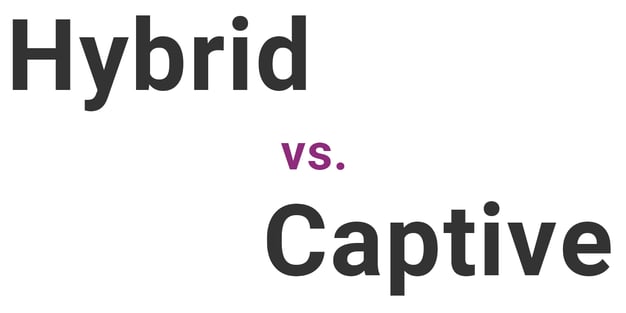December 16, 2023
Hybrid vs. Captive: Which Outsourcing Method Makes the Most Sense?
Written by: Andy Hilliard
When considering outsourcing, which should you choose: hybrid or captive sourcing?
Outsourcing software development is a challenging process. As ARC points out, there are countless development service providers available, and a big difference between “good” and “great.” The question is, “How do you find the best one for your organization?”
One of the challenges is choosing a partner that will get a project done on time, within budget, and with minimal problems. Ask these three essential questions when choosing a development partner:
-
How well do they communicate with the company, both internally as well as with your in-house team?
-
Are their customer service and human resources capabilities in line with your expectations?
-
Do they have the technical skills needed to successfully complete the project?
-
Are they able to complete projects on time? Be sure to check with at least three references.
Maybe you want your project done completely separate from your daily operations. Or you might want your own team involved in the outsourcing process. Before you decide to start outsourcing, explore this overview of the benefits and differences between a hybrid and captive offshore outsourcing model.

What is a Hybrid Outsourcing Model?
The hybrid model uses a blended team approach of resources from both your on-site teams and your outsourcing partner, maintaining tight control and collaboration while increasing team flexibility and throughput at a more cost-effective blended cost.
This model has proven to be extremely cost-effective while nurturing close relations and engendering a true partnership. You are able to watch over the process and provide real-time edits and direction while getting the necessary talent for the project.
Key benefits of this model include:
-
Leverage strong collaboration and communication
-
Establish and foster an “extended team”
-
Increase talent pool flexibility
-
Gain access to partner best practices
-
Couple local control and ownership with lower offshore pricing
-
Benefit from post-deployment support
What is a Captive Outsourcing Model?
A captive outsourcing model is essentially a corporate campus-based offshore. These captive organizations are overseas subsidiaries set up by global corporations to serve the parent company. They offer an alternative to contracting out projects directly to an unrelated offshore provider.
Organizations can choose from several different types of captive outsourcing models, depending on their specific needs and objectives. One popular model is the virtual captive, which involves setting up a separate legal entity in a different country. The parent company can take advantage of lower labor costs and tap into the local talent pool, while still maintaining control and ownership.
Key benefits of this model include:
-
Lower cost
-
Operational control
-
Access to specialized expertise
-
Intellectual property protection
-
Knowledge transfer
The Various Captive Outsourcing Models
Hybrid Captive
Hybrid captive models allow teams to continue to perform core business processes for the parent company, where some or a significant portion of non-core work is outsourced. Non-core work typically includes anything that isn’t directly related to the core competency of the parent company.
The primary advantage of adopting a hybrid captive model is the ability to free up valuable resources, both time and finances. By outsourcing non-core work, the parent company can redirect attention to strengthening and expanding its core business elements. This allows for a more focused approach toward enhancing product innovation, improving customer service and driving overall growth.
Shared Captive
Specifically, this type of shared captive center works for its parent company as well as external customers. This is both a potential revenue generator and a cost-sharing vehicle for the parent company.
Unlike traditional captive centers that solely serve the needs of the parent company, a shared captive center has the unique advantage of accommodating external customers as well. This expanded scope enables the parent company to tap into additional markets and diversify its client base. By offering their specialized expertise and shared services to external customers, the parent company can create new streams of income and fuel further growth.
Make the Right Outsourcing Choice
Choosing an outsourcing partner often requires an inordinate amount of due diligence, time, money, and energy coupled with experience and a comparative understanding of outsourcing best practices.
Accelerance connects its clients with the best-aligned expert outsourcing teams in its proven network of global software development partners. We’re able to reduce the risk, time, and cost associated with the outsourcing due diligence process.
Schedule a free appointment with an Accelerance trusted advisor for advice from the premier global software outsourcing authority®. Together, we can deliver top-tier software development resources and professional consulting services tailored to your specific needs.
Andy Hilliard
As CEO, Andy leads and advocates for the globalization and collaboration of great software teams with companies in search of talent, innovation and a globally-distributed extension of their engineering function and culture. Andy founded the ground-breaking nearshore software development services company, Isthmus Costa...
Recently Published Articles
View All Posts
Blog
November 7, 2012 | Andy Hilliard
4 Reasons to Choose China for Software Outsourcing
Blog
July 30, 2014 | Andy Hilliard
Anthropology and Outsourcing to the Philippines
Blog
January 15, 2018 | Andy Hilliard
Latin America Software Outsourcing: Everything You Need To Know
Subscribe to email updates
Stay up-to-date on what's happening at this blog and get additional content about the benefits of subscribing.

